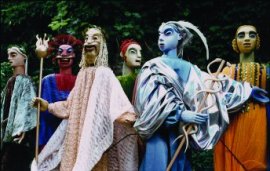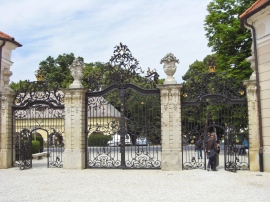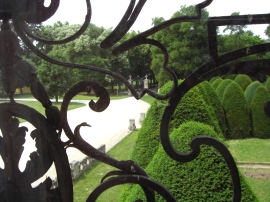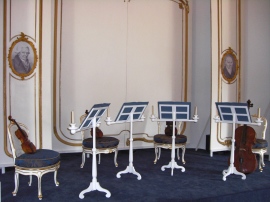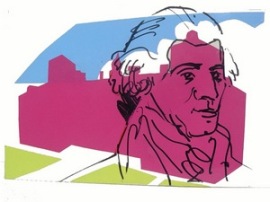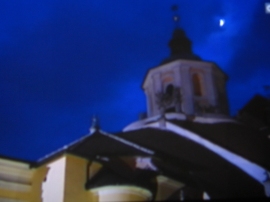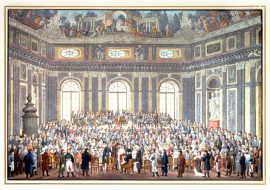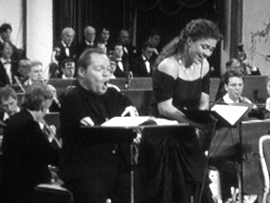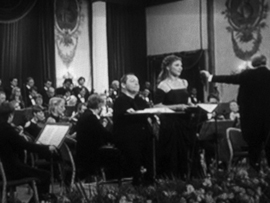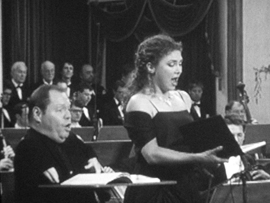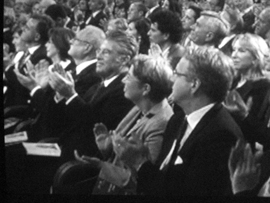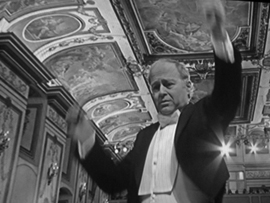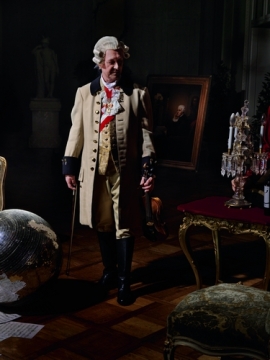200 Years, Anniversary Joseph Haydn (1732-1809)
haydnmania: the 2009 anniversaryArchive for music
what happend today (236 years ago!):
Sept 2, 1773:
PHILEMON UND BAUCIS – Joseph Haydn’s Marionette Opera had premiere at Esterháza (now known as Esterházy Palace, at Fertöd, Hungary)
more:
“If I want to hear good opera I must come to Eszterháza,” Maria Theresa is supposed to have said, giving a somewhat misleading impression. In fact she was there on only one occasion, for the first two days of September 1773. The large scale celebrations were written up in local newspaper reports. On the first day there was a banquet (at which three gamebirds killed by Haydn with one shot were on the Empress’s plate), the inspection of the Park, a performance of Haydn’s opera “L’infedeltà delusa” in the opera house, followed by a fancy-dress ball which lasted till dawn. During an intermission in the ball the Prince showed the imperial party his new Chinese Pleasurehouse. The walls were covered with mirrors which reflected the light of innumerable Chinese lanterns and candles. Haydn and the orchestra played a symphony and other works. The main ball took place in a 130 foot long Chinese gallery adjoining the opera house. Eleven chandeliers and 600 candles illuminated the room and the musicians were dressed in Chinese costume. It was the stove in this room that exploded in 1779 causing the fire that completely destroyed the first opera house and, far worse, all the music and parts of the operas written to date with the exception of the scores that Haydn had fortuitously taken to his living quarters some half mile away (still preserved).
The next evening’s entertainment started with Haydn’s specially composed marionette opera “Philemon und Baucis”, or “Jupiter’s journey to Earth”. This could well have been the official opening of the marionette theatre, which, unlike the rebuilt opera house and the Chinese Pleasurehouse, still can be seen, although now used for agricultural purposes. The auditorium was flanked on both sides by caves domed with rockery and sea shells in the fashionable rocaille style. Some of the caves were embellished with fresco paintings, others with miniature fountains.
The puppet opera was followed by a festive supper after which the Prince led the Imperial party through an avenue illuminated with coloured Chinese lanterns to the site of a spectacular firework display. Once seated the Empress lit the first fuse. After the fireworks an outdoor ball took place in a specially prepared arena, lit by more than 20,000 Chinese lanterns and with over a thousand young peasants performing local dances.
The opera was repeated at Eszterháza in 1776, presumably with a less elaborate final tableau, and was then available as two pieces, the prologue on Olympus as “Der Götterrat” and the main opera as “Philemon und Baucis”. At some time in the 19th century the music disappeared completely, though the printed libretto survived. In 1935 a manuscript score from about 1800 of the main opera was discovered in a Paris bookshop, without the prologue and without the final chorus, but with a lot of extraneous material by other composers that could be discarded thanks to the existence of the libretto. Music from earlier in the opera is repeated for the final chorus. It is generally agreed that the first two movements of Symphony No. 50 were the original overture to the prologue. H. C. Robbins Landon prepared a performing version and produced the first recording in Vienna in 1951.
The tale of Philemon and Baucis appears in Book 8 of Ovid’s Metamorphoses. Two tree trunks grow together in a walled enclosure on a hilltop, surrounded by a swamp, in Phrygia. The story is that the gods destroyed the village but left a temple with the old couple to look after it. Their one wish was to die together when their time came and they were transformed into an entwined oak and a lime. The libretto Haydn set is based on a play by the blind Alsatian poet and teacher, Gottlieb Konrad Pfeffel, presumably found and adapted by the Esterházy librarian, Philipp Georg Bader. Gounod composed a version of the story in 1860. In this very French operetta Baucis asks for the return of her youth, Jupiter falls in love with her and a second wish returns her to Philemon and safe old age.
the Haydn Church
Here a video introducing the Haydn Church in Eisenstadt, where Haydn worked – and, at least is buried in the “Haydn Mausoleum”:
Haydn at Esterháza (Fertöd, Hungary)
“…Well, here I sit in my wilderness – forsaken – like a poor waif – almost without any human society – melancholy – full of the memories of past glorious days – yes! past alas! – and who knows when these days shall return again? Those wonderful parties? Where the whole circle is one heart, one soul – all these beautiful musical evenings – which can only be remebered and not described – where are all these enthusiastic moments? – all gone – and gone for a long time…”
This is the beginning of one of Haydn’s remarkable letters, written to Maria Anna von Grenzinger in February 1790 shortly after his return to Eszterháza from the Christmas season in Vienna. This letter contains a rare glimpse of Haydn out of livery as “Capellmeister of His Highness the Prince (Esterházy) in whose service I live and die”, as Haydn had styled himself in another well-known letter, his autobiography of 1776.
When Baron Riesbeck visited Esterháza in the 1780s he observed that “The Neusiedler See, from which the castle is not far removed, makes miles of swamp and threatens in time to swallow up all the land right up to the Prince’s dwelling.” When Haydn used the term Einöde to refer to Esterháza he was perhaps translating the Hungarian term for the marshy plains of the area – puszta, which means “wilderness”.
Haydn’s life at Esterháza apparently hinged on extremes of luxury and privation. Descriptions of the Hungarian Paradise invariably dwell on the lavish furnishings, exquisite collections, and dazzling theatrical entertainments that won it so many accolades.
At Esterháza Haydn lived with the other musicians, singers and traveling players in the Musicians’ Building, a two stried building of 250 rooms. It was from his appartment there that he wrote his letters to von Genzinger.
link to my article “visiting Esterháza Palace”
“Haydn explosive” – an extraordinary exhibition!
This weekend I visited the “Haydn explosive. A European career at the court of the Esterházy Princes”- exhibition of the Esterházy Foundation at Schloss Esterházy at Eisenstadt.
Whow!
The Impressions I got were beyond comprehension: so poignant and overwhelming! And too much for one visit! If you go there, take time – one hour is almost not enough, believe me! (Ofcourse I plan my next visits there!)
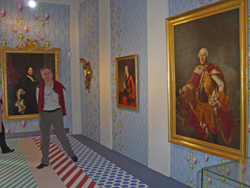
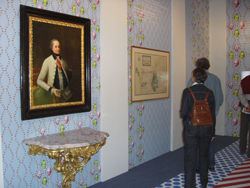
The visitor’s experience starts right at the entrance and one does not know, where to go or look first: the wallpapers of Franz West, the expansive carpet of Roy Lichtenstein – both makes you suddenly feel that this exhibition is different!
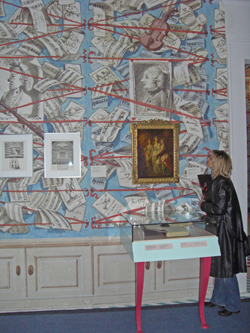
And you walk through the rooms and exhibits with the wide open eyes of a child and a certain explorer-attitude (this was definitely my impression!) to find out more about this genius Haydn and the influences around him today and yesterday!
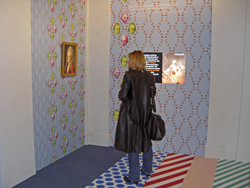
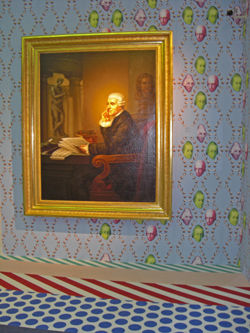
His relationship to the Esterházy-Dynasty, the age of his life and the effects of his works – all these things (and much more!) are presented and documented as well with historical exponats as with contemporary works in a sensational well-founded and appealing way.
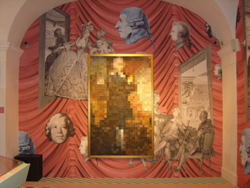
Haydn, “pixeled”!
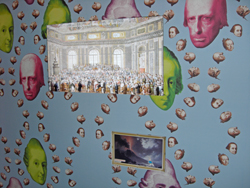
Monitors in the walls present information in a diversified way.
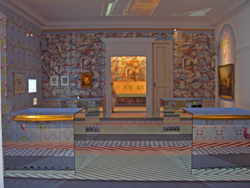
The explosion (videoinstallation) on the ceiling
is connecting the next (musical and visual) experience, the string quartet: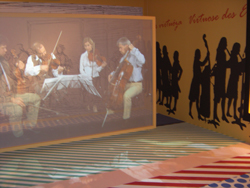
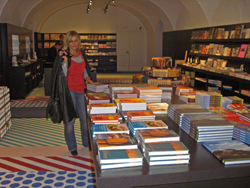
At least you go through the museum shop: books, Cds, ….. – it was too late for me to forage for things that might be interesting for me – because it was closing time! So I have to come once (or twice or …. ) more!
Opening times:
daily from 9 am to 6 pm
Sala Terrena, Esterházy
Palace, Eisenstadt
Gala concert with the prizewinners
picture © “haydn explosive”, Esterházy Foundation
The “International Joseph Haydn Chamber Music Competition” organised by the University of Music in Vienna has been held ever since 2001. An eminent international jury elects the participants.
As a tribute to Haydn – the composer of genius – on the bicentenary of his death, the competition is being held a year early instead of retaining the triennial interval.
The 4th competition took place in Vienna from 15 to 23 April 2009, and the grand finale will be the galaconcert on friday, april 24 at Schloss Esterházy (Haydnsaal), Eisenstadt at 7.30 pm played by the prizewinners, organised by the Esterházy Private Foundation .
A novelty of this year’s anniversary competition will be the presentation of new compositions by the composition classes of the University of Music and the Performing Arts.
amendment:
the audience’s prize ( € 4.000,-) was won by the polish-german “Berolina Trio”
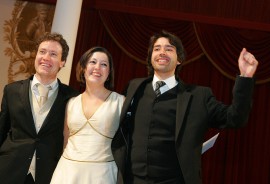
Fotocredit: F.E. Familien-Privatstiftung Schloss Eisenstadt /APA-OTS/Peter Hautzinger.
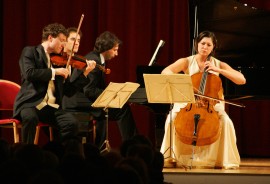
Fotocredit: F.E. Familien-Privatstiftung Schloss Eisenstadt /APA-OTS/Peter Hautzinger

